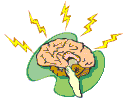Bird Brains and Memory Chips
We have to be amazed at the memory capacity of modern computers. The fact
that so much memory can be stored in such a small space is a tribute to the
men and women who design and build these marvelous machines that have so radically
impacted our lives.
 One of the things that the capacity of computers tells us is that the brains
of living things cannot be the result of chance. Birds are a classic example
of incredible storage of memory. Recent studies of Clark's nutcracker, for
example, have shown that a single bird can store 33,000 pi–on nuts in thousands
of caches during the late summer. During the winter, the birds not only
find and eat a vast number of these nuts, but also never return to a cache
they have emptied.
One of the things that the capacity of computers tells us is that the brains
of living things cannot be the result of chance. Birds are a classic example
of incredible storage of memory. Recent studies of Clark's nutcracker, for
example, have shown that a single bird can store 33,000 pi–on nuts in thousands
of caches during the late summer. During the winter, the birds not only
find and eat a vast number of these nuts, but also never return to a cache
they have emptied.
It has always been assumed that birds find the nuts by random searching
or by smell, but behavioral studies have not shown random searching nor repetitive
behavior. The brain of these nutcrackers is the size of a pea, and much
other information besides nut location is stored there.
 Memory chips require a very intelligent engineer to not only structure the
storage locations, but to load the data and then retrieve it. These bird
brains are more complex than the best chips--designed by an engineer of great
intelligence and using practical techniques of recall. Behold the fowls
of the air: for they sow not, neither do they reap, nor gather into barns;
yet your heavenly Father feedeth them (Matthew 6:26).
Memory chips require a very intelligent engineer to not only structure the
storage locations, but to load the data and then retrieve it. These bird
brains are more complex than the best chips--designed by an engineer of great
intelligence and using practical techniques of recall. Behold the fowls
of the air: for they sow not, neither do they reap, nor gather into barns;
yet your heavenly Father feedeth them (Matthew 6:26).
--Reference: Scientific American, March, 1983, Bioscience,
June, 1983.
Back to Contents
Does God Exist?, MarApr02.
 One of the things that the capacity of computers tells us is that the brains
of living things cannot be the result of chance. Birds are a classic example
of incredible storage of memory. Recent studies of Clark's nutcracker, for
example, have shown that a single bird can store 33,000 pi–on nuts in thousands
of caches during the late summer. During the winter, the birds not only
find and eat a vast number of these nuts, but also never return to a cache
they have emptied.
One of the things that the capacity of computers tells us is that the brains
of living things cannot be the result of chance. Birds are a classic example
of incredible storage of memory. Recent studies of Clark's nutcracker, for
example, have shown that a single bird can store 33,000 pi–on nuts in thousands
of caches during the late summer. During the winter, the birds not only
find and eat a vast number of these nuts, but also never return to a cache
they have emptied. Memory chips require a very intelligent engineer to not only structure the
storage locations, but to load the data and then retrieve it. These bird
brains are more complex than the best chips--designed by an engineer of great
intelligence and using practical techniques of recall. Behold the fowls
of the air: for they sow not, neither do they reap, nor gather into barns;
yet your heavenly Father feedeth them (Matthew 6:26).
Memory chips require a very intelligent engineer to not only structure the
storage locations, but to load the data and then retrieve it. These bird
brains are more complex than the best chips--designed by an engineer of great
intelligence and using practical techniques of recall. Behold the fowls
of the air: for they sow not, neither do they reap, nor gather into barns;
yet your heavenly Father feedeth them (Matthew 6:26).